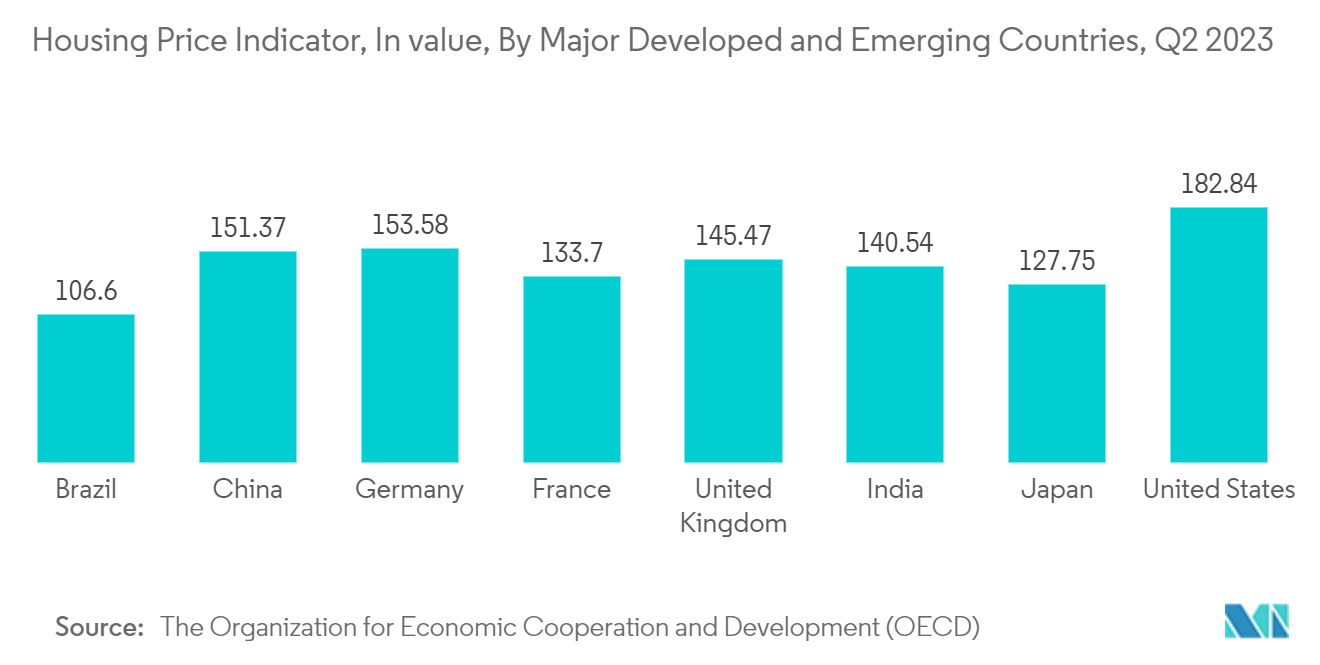Market Trends of Building Insulation Materials Industry
The Residential Segment to Dominate the Market
- Insulation of residential buildings is gaining popularity due to its architectural and energy-efficiency benefits. Promoting energy efficiency (EE) requirements for new residential buildings has been proven an effective mandatory policy instrument to slow down the increase in energy consumption in the residential building industry.
- Residential construction across the world has witnessed significant growth over the past few years due to population growth, migration from rural areas to service sector clusters, and the growing trend of nuclear families.
- According to the US Census Bureau, the value of private construction in 2023 stood at USD 1,541.0 billion, 4.7% (± 1.2%) higher than the USD 1,472.4 billion in 2022. Residential construction spending in 2023 was USD 864.9 billion, up by 5.8% (±2.1%) from USD 917.9 billion in 2022, while non-residential construction spending accounted for USD 676.0 billion, up by 21.9% (±1.2%) from USD 554.5 billion in 2022.
- The Brazilian government plans to invest BRL 278 billion (~USD 52.19 billion) in popular housing and urbanization works by 2025. This amount will allow contracting up to 2.5 million housing units with very reduced interest rates.
- In recent years, the highest growth rate in residential construction was registered in Asia-Pacific, owing to the expanding housing construction markets in China and India. The housing authorities of Hong Kong launched several measures to accelerate the construction of low-cost housing. The officials aim to provide 301,000 public housing units by 2030.
- According to the Indian government, by 2030, more than 40% of the Indian population is expected to live in urban India, likely creating a demand for 25 million additional affordable housing units.
- As of January 2023, the target to build 26 million houses in the Pradhan Mantri Awas Yojna (PMAY) by 2022 lagged in rural areas as only 21 million houses were built, due to which only 72% of the target was achieved. In urban areas, the target was only achieved by 51%, i.e., out of the 12.5 million houses promised, only 6.12 million were built. In order to ensure the completion of the target, PMAY schemes (for both rural and urban areas) have been pushed till 2024.
- The abovementioned factors are likely to positively affect the demand for building insulation in the residential construction industry during the forecast period.

Europe to Dominate the Market Studied
- Insulation enables the maintenance of the desired temperature in buildings, protecting them against cold in winter and excess heat in summer. A well-insulated house is quite energy efficient and also reduces environmental emissions.
- Europe is undergoing a building renovation wave because the European Commission aims to improve energy efficiency, boost the economy, and deliver better living standards for Europeans. The renovation wave aims to renovate both public and private buildings and at least double the annual energy renovation rate by 2030, in addition to reducing emissions and creating green jobs in the construction industry.
- According to the FIEC (European Construction Industry Federation) Statistical Report 2023, investment in new housebuilding in 2023 was projected to decrease by 3.2%, with the largest drop expected in Sweden (-42.4%). Moreover, in 2022, investment in renovation was most significant in Italy, with an increase of 22% over the previous year.
- This renovation wave will substantially increase the demand for building insulation materials across European countries during the forecast period.
- Germany has the largest construction industry in Europe. Its economy is the largest in Europe and among the top five in the world. The country also has the largest housing stock among European countries, which indicates its dominance over the demand for building insulation materials.
- In Italy, the market for modular construction is expected to increase significantly during the forecast period, with an increase in residential construction activities and various institutional projects. According to Eurostat (a directorate-general of the European Commission), construction revenue in Italy is anticipated to reach around USD 57.68 billion by the year 2025.
- The Global Gateway is a project planned by the European Union to develop new infrastructures. The European Commission said the European Fund for Sustainable Development will make up to EUR 135 billion (~USD 143.84 billion) available for investments in infrastructure projects between 2021 and 2027.
- Overall, the demand for building insulation materials in Europe is expected to grow, benefiting the market studied.


